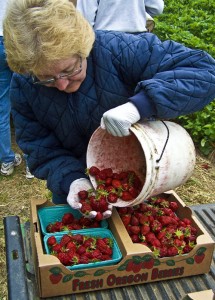(Editor’s note: Sharon Barnes’ family has raised strawberries since the mid-1920s and sells them every summer through their sales stand at Ace Hardware in Stayton.)
Not so long ago, local strawberries were plentiful and inexpensive. Today, with fewer growers raising them, strawberries have increased in price and consumers are much more interested in quality and how to care for their investment. Following are some of their most frequently asked questions.
How do I know when I’m getting the best value?
Consider the grower’s reputation, how full the flat is and the variety of strawberry (some of the most popular varieties can be costlier to produce.) Overall quality and freshness are important to consider. Even a bargain can be expensive if you end up throwing a lot of strawberries away.
How can I tell if they’re fresh?
Fresh picked strawberries are firm and bright with an almost glossy sheen. Day-old berries start to look dull, dark and a little sad. If in doubt, feel free to ask when they were picked.
Why don’t Oregon strawberries “keep” like the California varieties?
Natural sugar content. The upside of natural sugar is the incomparable flavor of local berries. The downside is fermentation. Fermentation of the natural sugar causes Oregon berries to break down and begin to spoil soon after picking.
To enjoy best quality and flavor, plan to eat, freeze or process your strawberries on the day of purchase.
Refrigeration can help maintain firmness and freshness for a day or two. Don’t wash the strawberries or remove their green caps until you’re ready to use them. Layer them in a container between sheets of paper towels.)
Just be sure to follow safe food-handling practices and protect the berries from cross-contamination with other food items in the fridge, including raw meats and poultry.
For best results, don’t try to hold over a large quantity of strawberries. If you can’t get to your jam right away, clean and crush the berries, then bag and freeze the pulp in the quantity your recipe calls for. Later, you can thaw the individual bags and make jam.
What’s the difference between a “crate” of strawberries and a “flat” of strawberries?
These terms are used interchangeably but, technically, a “crate” refers to the large plastic container used by commercial strawberry growers. These growers sell to canneries by the pound and a crate can hold as much as 20 pounds.
Fresh market growers tend to use the term “flat” to differentiate their 12-pint cardboard container. These growers usually sell by volume rather than by the pound, offering you a choice of a standard single pint, three-pint basket or 12-pint flat.
How many batches of jam will I get from a flat?
That depends on how many cups of crushed strawberries you need. A 12-pint flat of whole strawberries yields approximately 12 cups crushed.
Are some varieties better than others for jams, syrups and freezing?
Most strawberry varieties make good jam and syrup, but many recipes call for lots of sweetener and the strawberry flavor can get lost. To maintain flavor intensity, consider a tarter strawberry for jam and syrup than you might normally prefer for fresh eating.
For freezing, firm-bodied varieties tend to hold their texture better after thawing.
Are your strawberries sweet?
Besides natural sugar, strawberries are also high in ascorbic acid (vitamin C), which gives them their distinctive tart/sweet flavor. Some varieties have higher sugar-to-acid ratios; some are higher in acid.
Fortunately, local growers offer several different kinds so, whether you prefer a mild flavor or a berry with a delicious kick, you’re sure to find a favorite.
If in doubt, ask if it’s okay to taste test before buying and let your taste buds be the judge.
Are strawberries nutritious?
Strawberries are a powerful “farmaceutical.” One cup of halved fresh berries can provide up to 140 per cent of the recommended daily allowance of vitamin C. They’re also a source of potassium, magnesium, phosphorus, selenium, vitamin A and fiber.
According to Dr. Barry Sears, author of The Top 100 Zone Foods, strawberries are superstars when it comes to anti-oxidant power. And they contain ellagic acid, a plant compound that may help combat carcinogens.
What more refreshing way to “take your medicine” than over short cake and ice cream, in a pie, on your breakfast cereal, or in a refreshing milk shake, margarita, lemonade or smoothie? Enjoy!
